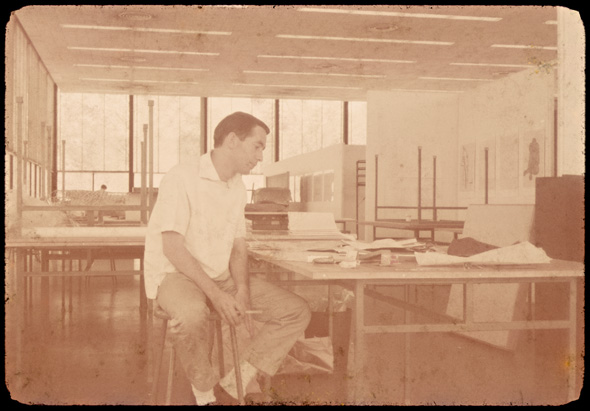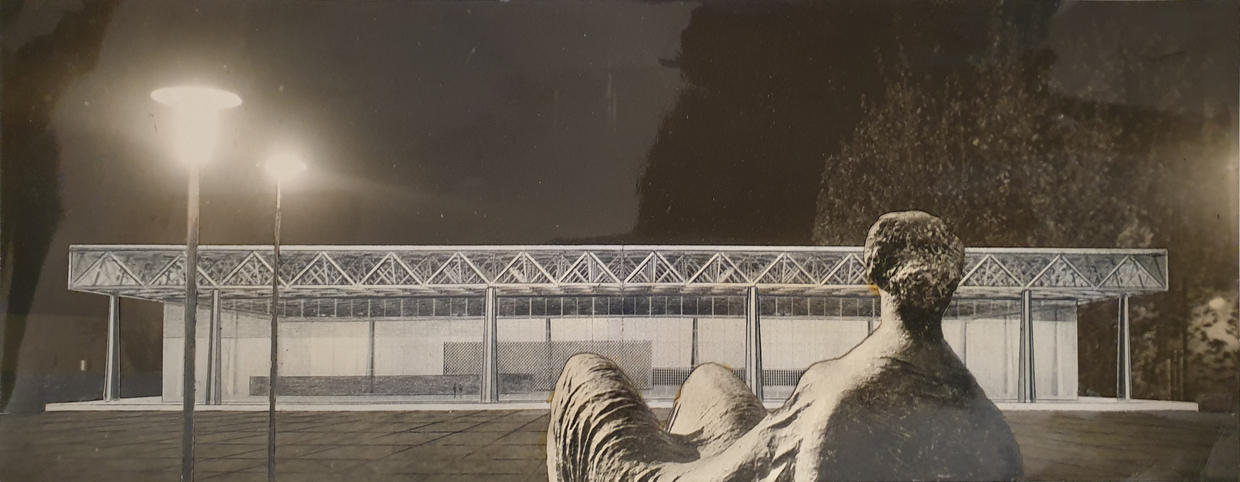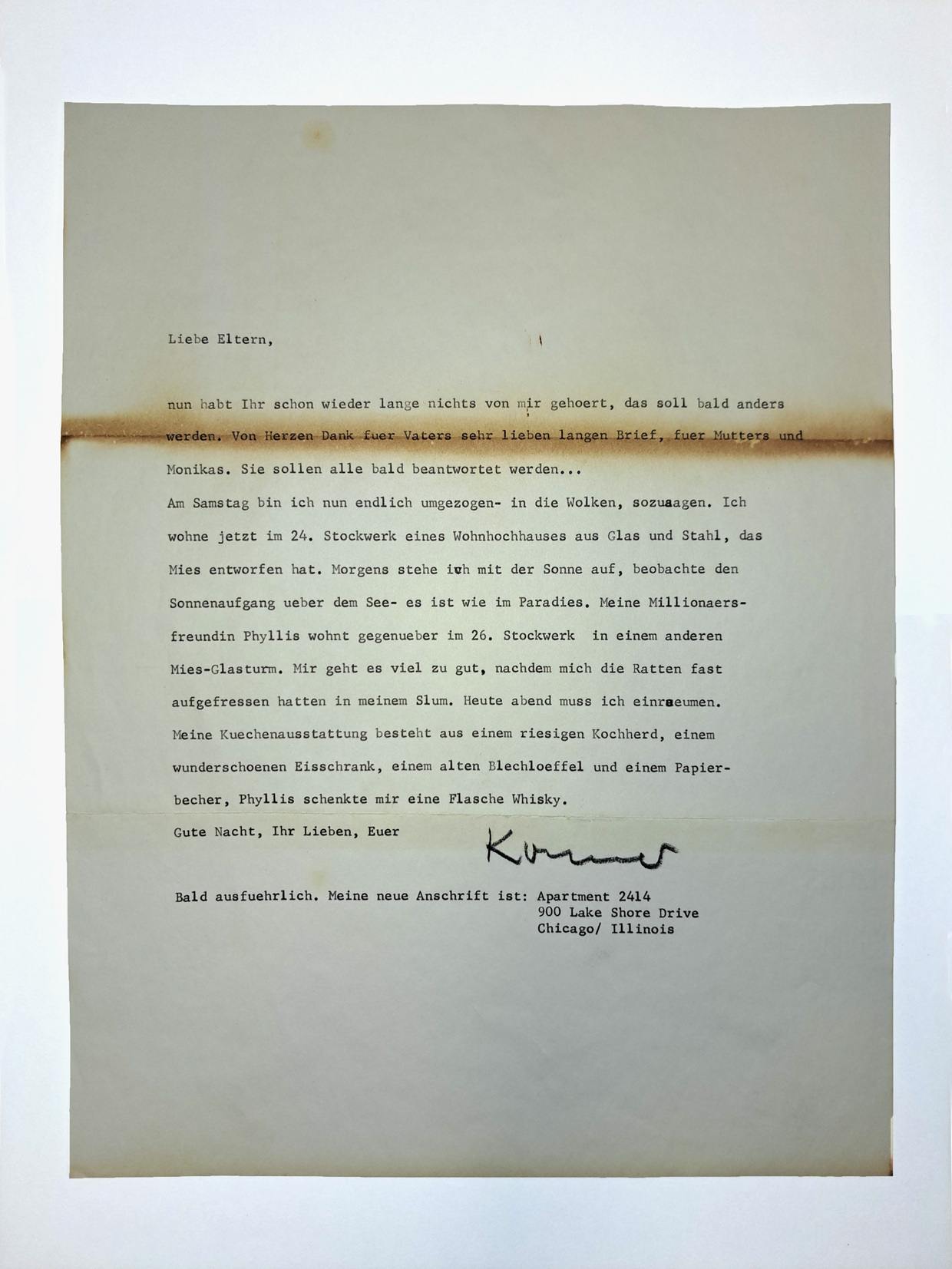USA *01

As a schoolboy, Conrad Roland dreamed of traveling to the USA. But it was not until years later, after an apprenticeship as a carpenter and a degree in architecture at the Technical University of Munich, that he was given the opportunity to continue his studies at the Illinois Institute of Technology (IIT) in Chicago with Ludwig Mies van der Rohe, Ludwig Hilberseimer and Walter Peterhans thanks to a Fulbright scholarship. The Fulbright Program, an international exchange program founded in 1946 between the United States and now more than 160 countries, was part of the reeducation strategy, especially for the Federal Republic of Germany. The aim was to democratically shape German citizens through the experience of an American academic year and to establish the "American way of life" as a cultural model in the Western world.
With his numerous letters to his parents, which he wrote with impressive regularity on his "brittle girlfriend 'Lettera' (Olivetti typewriter) 1 ", Roland unconsciously fitted into this strategy. The letters not only offer insights into his personal everyday life. Carefully formulated, "Konner", as he was called in the family, described in dazzling colours the supposedly glamorous life of a simple architecture student in the midst of an illustrious society of the architecture scene. With admiring glances, he described to his family the environment of star architect Mies van der Rohe, where the "real Paul Klee above the dining table"2 was part of the standard equipment.
The documents are almost exclusively written by Roland himself. His parents' answers are not on hand at the saai | Archive of Architecture and Civil Engineering. In their effect, the letters are reminiscent of the mechanisms of today's social media channels, in which personal experiences are curated and presented in a targeted manner. Roland's letters, however, were not aimed at a broad public, but were limited to close, private communication with his family. Nevertheless, they reflect not only personal experiences, but also the cultural and social currents of the time.
Even during the two-week crossing from Bremerhaven to New York in the late summer of 1957, Roland took the opportunity to express his anticipation in a detailed letter to his parents and to describe the exuberant atmosphere on board. Together with around 100 other Fulbright scholarship holders – a "colorful bunch from all parts of Germany" 3 – they celebrated, danced and sang. At the same time, he was inspired by the stories of a former IIT student who had already successfully found his way into the American architecture scene. Arriving in Chicago, the high expectations of the young architecture student were by no means disappointed. He was particularly impressed by the Crown Hall, the building designed by Mies van der Rohe, which had opened a year earlier as an architecture school. After only two months, he reflected on his role as a student and his relationship with Mies in another long letter:
"How do I feel about Mies? As a student, I try to understand the Master. I try to understand the spirit that is so clearly and beautifully expressed in his work. What is the essence of our time, where is the genuine, original spirit that our architecture is supposed to embody. […] Mies himself warns again and again how crucial it will be for each of us to be clear about the time in which we live, what characterizes this time. Many experiences and adventures will be necessary to form this image, because only then will we be able to go our own way. This own way, however, does not mean originality, but a common search for truth. This requires independent thinking, a clear insight and a positive commitment to one's own time." 4
This striving to grasp the essence of time and to find an architectural answer to it became a central goal of Roland's stay in the USA. The intensive examination of Mies' ideas about universal architectural language and truthfulness had a lasting influence on him and thus also on his study designs. It was not without pride that Roland described his design for a residential house to his father in the same document:
"The house is a steel structure with a roof made of a grate of intersecting sheet steel [...] There are no supports inside the house, all exterior facades are glazed. If you want to be alone, you just close the large curtains and then you have a house with a kind of colored, transparent walls. Inside is the so-called "core", the mechanical heart or center, in which there is a bathroom, laundry room, ample closet and storage room [...]. It's all difficult to explain in words, but it works well and looks clear and beautiful." 5
Roland was particularly proud to experience Mies not only as a teacher, but also to gain insights into Mies' personal environment and life and thinking through his friendship with his grandson Dirk Lohan – 6"apparently not spoiled by Mies for educational reasons, although his grandfather is undoubtedly a millionaire":
"On Friday, Mies had invited us again and we discussed until late into the night [...]; the old master then sits in his huge living room surrounded by his wonderful clover paintings, puffs on his cigar and explains his ideas to us.-Great and essential thoughts about architecture and civilization." 7
The absolute highlight, however, was Roland's move into an apartment in a high-rise building designed by Mies on Lake Shore Drive together with Dirk:
"On Saturday I finally moved - into the clouds, so to speak. I now live on the 24th floor of a high-rise apartment building made of glass and steel that Mies designed. In the morning I get up with the sun, watch the sunrise over the lake - it's like paradise." 8
But Roland took a critical look at the American culture of life as well. In his letters, he described the ambivalence of American society:
"Bigoted, mendacious philistinism prevails here as well as in any other country ... I am firmly convinced that there are at least as many independently thinking and really educated people in the USA as in Europe. … one can say of this country in every respect pretty much exactly the opposite of the current judgments and prejudices. Many people are narrower than the nailed down German philistine and others have a broad horizon and are full of genuine enthusiasm, which is often missed in our country." 9
Despite these ambivalent observations, Roland did everything he could to extend his one-year stay in order to complete his studies with a Master of Sciences in Architecture. To this end, he planned to work in Mies van der Rohe's office, as he had to finance his own living expenses after the scholarship expired.
"I want to ask [Mies] this week if I can work in his office at least during the summer, that would of course be the non plus ultra. Otherwise, the employment situation is still very bad, ... there is still no talk of an end to the recession." 10
This dream came true despite the economic difficulties, and over time Roland's relationship with Phyllis Lambert, the daughter of the president of the Seagram whisky dynasty, deepened. He explained their family background to his parents and enthusiastically described the "highly charming and unusual change in [his] bachelor life" 11 through the time he spent together with his "whisky princess“ 12:
"I don't know if the connections are really clear to you: Phyllis is the daughter of the president of the largest American whiskey company, for which Mies built the famous skyscraper, the Seagrams Building, in New York three years ago. At that time, she had visited all the well-known architects in the USA on behalf of her father and then finally commissioned Mies to do it and played the client, so to speak.... No doubt a most stimulating company for your son."13
Over time, Phyllis Lambert became a central figure in Roland's life – both as a patron and architectural companion and as a close confidant. While he often presented his parents with a partly idealized account of his life, the letters to Lambert allow a more unobstructed view of Roland's professional and private development as well as of the dynamics of an international network that significantly shaped his future and deserves its own consideration.
MG, 20.1.2025
1 Letter to his mother, 1959
2 Letter to his parents, undated (probably January 1958)
3 Letter to his parents during the crossing on the M.S. Berlin, August 1957
4 Letter to his parents, Dezember 1957
5 Ibid.
6 Ibid
7 Letter to his parents, o.D.
8 Letter to his parents, o.D. (probably Februar 1958)
9 Letter to his parents, Dezember 1957
10 Letter to parents, Easter, o.D. (probably 1958)
11 Letter to his father, 1960
12 Ibid.
13 Letter to his parents, September 1959 (oder 1960)



